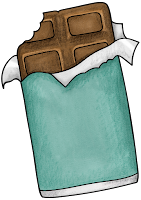We've all seen our students write stories that begin with the same subject in each sentence.
He went to the store.
He bought a candy bar.
He ate it on the way home.
BORING.
Today's focus is varying sentence structure in writing, which can also be called using syntactic variety.
First off, if the subject is the same, students can combine the sentence into one sentence with series commas.
He went to the store, bought a candy bar, and ate it on the way home.
That fixes the feel of being in a car where the driver constantly slams on the breaks. Of course, this sentence has other problems, but if you've been following my writing articles, you know what to do!
Syntactic variety not only means joining sentences for smoother prose but also sprinkling short sentences along with the long ones to make for a better sounding passage.
 |
| In Love with Chocolate! |
When Malcolm entered the Sweetie Pie candy shop, he spotted his favorite chocolate bar. The dark chocolate Millie bar, complete with marshmallows, almonds, and honey waited for the taking. Yum! Unfortunately, the Millie is the most expensive candy bar in the shop. $3.45 for one delightful taste. It was worth it! He carefully dug a five dollar bill out of his pocket and handed it to the waiting clerk. Before he could step out of the store, Malcolm had already ripped the wrapper. The sweet chocolate sloshed around in his mouth providing ecstasy!
Notice the shorter sentences sandwiched between the longer ones. Also, the sentences do not all start with "he" or use the same structure. That is syntactic variety. To teach this skill, have your students play with simple sentences or ideas. Tell them to include an interjection (Wow! Yay! Yikes!) somewhere between their long sentences. This technique will make their passages shine.
If you are interested in teaching students to vary their sentence structure, below is a link to a PowerPoint lesson that does just that.
I send these posts to my mailing group; however, they get free resources along with the article. You can, too. Just join my group by clicking below!
You will also receive a FREE No Prep Problem Solving Pack!
I hope you've enjoyed my series on writing skills. Tune in next month where I will provide guidance on things to do in October.
Thanks to Kate Hadfield Designs for the clipart.










